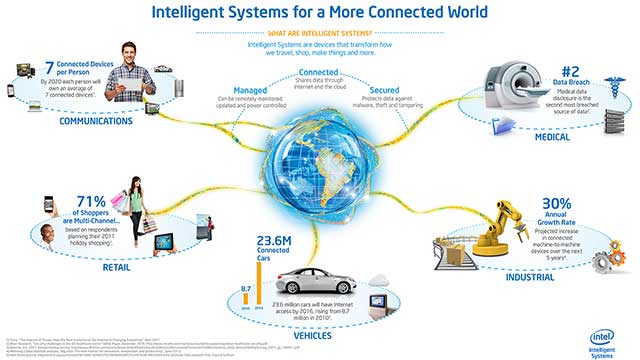Internet-of-Things (IoT): Bright Future for Smart Gadgets
The concept of “Internet-of-Things” was formulated in 1999 and since then has been growing at an ever-increasing rate. In fact, everything related to digital technology is growing fast. Organized into networks, the intellectual physical systems acquire the ability to synchronize and communicate with each other, thus excluding the need for people to interfere into some routine procedures. It is very convenient.
In fact, the Internet-of-Things was born somewhere in 2008-2009 when the number of digital gadgets exceeded the population on Earth. The analysts predict that in four years, by 2020, the IoT sphere will be populated by 26 billion devices actively transmitting data between each other via the Internet.

Intelligent systems for a more connected world
Cisco specialists estimate the market size of the IoT by the year 2025 to be 19 trillion dollars in current prices. Starting with 2014, some schools in UK introduced a new subject into the curriculum: coding. The new era of coders begins. Todays schoolchildren will be well equipped to influence the world we live in, more so than ever before. From the lofty and highly specialized area the programming, or coding, will gradually turn into a routine skill, writing codes in the 21st century will be a basic skill comparable to the 20th century writing and reading.
With the expected growth of the IoT there will be a multitude of data sources, devices and objects to connect and communicate with. These data sources will open the doors to completely synchronized and fully-integrated retail experiences, health care services, leisure and tourism activities, to communication with domestic appliances etc. We live on the brink of a new industrial revolution in the area of digital technology.
To say nothing of advertising! Digital Signage already plays a crucial role in the IoT, its establishment in our consciousness as an indispensable marketing tool. Digital screens and displays already learned to communicate with each other, interacting with physical objects around them and their data sources. The screens are smart enough to request the necessary information from data-centers, independently take decisions about the type and scope of the necessary services.
At times, such independence leads to innovative forms of interaction. For example, when a screen is activated by wind pressure change when the train enters the subway platform and automatically changes content presentation showing the adverting on the background of a pretty girls face with the hair blown by the wind. The research of Swedish market experts (for this unconventional approach to advertising was introduced on Stockholm metro) proved that this “intellectual” approach to advertising proved to be very effective.
Linking the arriving metro train with the advertising content
Another good example could be drawn from iBeacon, the technology that enables smartphones, tablets and other devices to perform actions when in close proximity to a hosting device. iBeacon uses Bluetooth low energy proximity sensing to transmit a universally unique identifier picked up by a compatible applications. At ISE, Scala demonstrated this technology by asking people to pick up sportswear from the stand and viewing the changing advertising content on the nearby screen.
Scala connects the physical and virtual worlds at ISE 2015
The expectation of communication between devices and objects will rise as more and more products are developed to incorporate multiple devices. Recently the well-known marketing agency Gartner has already highlighted products such as advanced medical devices; factory automation sensors in industrial robotics; sensor motes for increased agricultural yield; automotive sensors and monitoring systems for sectors such as transportation, water distribution and electrical transmission. The world is turning into the global network of computers, information and video cameras, databases and mobile gadgets.
However, as the number of digital devices grows, the danger of digital hacking, virtual break-ins, data interception and substitution becomes realistic and almost inevitable. And when schools in England and other developed countries start teaching coding to thousands of smart kids (whose first instinct will be to misuse the newly acquired skill and do wonders to completely unprotected digital devices around them) the situation may well become uncontrollable. It is not the time to think ahead and start building in some measure of security to protect current millions and future billions of digital devices, without which our life is no longer possible.





